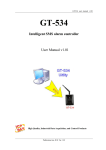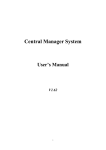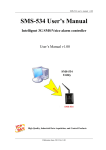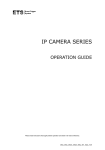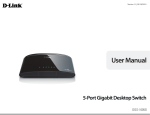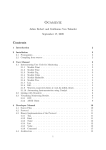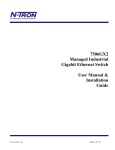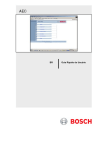Download User Manual
Transcript
Central Manager System User’s Manual 3.42 i 2nd Edition (Aug-17-11) Content C O N T E N T CO ON NT TE EN NT T .............................................................................................................................................. I 1. PREFACE ..........................................................................................................................................1 2. INSTALLATION.................................................................................................................................2 2-1. Install CMS.........................................................................................................3 3. PROFILE MANAGER ........................................................................................................................5 3-1. Create a New User Profile ..................................................................................5 3-2. Delete Profile......................................................................................................6 3-3. Edit Profile..........................................................................................................6 3-4. Import profile......................................................................................................7 3-5. Export Profile .....................................................................................................7 3-6. Login...................................................................................................................8 3-7. CMS Log Query .................................................................................................9 4. MAIN SCREEN................................................................................................................................10 4-1 Main Screen.......................................................................................................11 4-2 Display mode.....................................................................................................18 4-3 Setup ..................................................................................................................22 4-4 Snapshot.............................................................................................................39 4-5 Full Screen.........................................................................................................40 4-6 Event to Zoom ...................................................................................................40 4-7 Playback.............................................................................................................42 4-8 E-MAP...............................................................................................................48 4-9 Quick Select Tag ...............................................................................................57 4-10 Log System Status Window ............................................................................58 4-11 Central Backup ................................................................................................60 4-12 Use Local Playback .........................................................................................68 5. APPENDIX ......................................................................................................................................71 5-1. Maintenance......................................................................................................71 5-2. FAE Support .....................................................................................................71 i 1. Preface Central Manager System(CMS) is a powerful remote manager system. It can allow administrator to manage video recorders through network located in different sites from one point of control. Each CMS system can manage up to 64 sets of video recorders with maximum 4096 channels. You can monitor, playback, backup the video files from the video recorders through network at any time. You can also proceed to set up the remote system configurations. With user friendly GUI, administrator can monitor the video recorders very easily. 1 2. Installation CMS can serve up to 64 sets of video recorders (4096 channles) including DVR, Hybrid DVRs or NVRs at the same time. Before the installation, make sure your computer meets the following minimum requirement for connecting video recorders. CMS supports DVR, Hybrid DVR and NVR firmware versions, Product DVR Hybrid DVR NVR Product Firmware Version V3.60, V3.81, V4.00, V4.20, V4.23, V5.00, V5.01, V5.02, V5.06, V5.20, V6.00, V6.20, V6.30, V6.40, V6.61 , V7.40 and V7.43 FV5.06, FV5.20, FV6.00, FV6.20, FV6.30, FV6.40, FV6.61 and FV7.40 NV5.06, NV5.20 NV6.00, NV6.20, NV6.30, NV6.40, NV7.40 and NV7.43 CMS OS CPU Display Card RAM Hard Disk Network Card Mouse DVD-ROM USB Interface DirectX Requirement Windows 7 Ultimate 32bit WinXP Professional 32 bit SP1/SP2/SP3 Core 2 Duo 2.5G and above *Intel On-board VGA *Nvidia – 7xxx series, 8xxx series VGA card *1024*768 screen resolution 2GB and above 250 GB and above (System files and Backup files should be in the same HDD section) 10/100/1000Mbs PS/2 or USB compatible General 1.1 / 2.0 V7.0 & above For connecting to DVR V5.10 and above versions, two hardware components should be upgraded as below, CMS200 CPU RAM Requirement Intel Core 2 Duo E6300 1.86G and above 1G and above 2 2-1. Install CMS Before you install CMS 3.42, please make sure if your PC system is already installed "Microsoft .Net framework 3.5". If not, please go to the following website "http://download.microsoft.com/download/5/6/7/567758a3-759e-473e-bf8f-52154438 565a/dotnetfx.exe" and download "dotnetfx.exe" to your PC system. Execute this program and now you can start to install CMS200 V3.42. Step 1 Insert the installation CD. Step 2 Then, go to the directory to run the Setup.exe and follow the steps. When finishing the setups, it will show up the message. Then, you can find the “Central Manager” folder and its sub menu from the Windows Start menu. 1. Tools Backup Information Tool By using this tool, you can get the information of backup file. Please refer to the Chapter 4-11 Central Backup for the backup configuration. Setup You can change CMS operation language in this menu. CMS runs in Microsoft Windows platform. When CMS is activated, it will detect the Windows Language version and automatically switch CMS operation language with other language options according to the rule described in following table. 3 Microsoft Window Language version English Traditional Chinese Simplified Chinese Japanese French, German, Polish, Portuguese, Spanish, Dutch, Russian Default CMS Operation Language English Traditional Chinese Simplified Chinese Japanese English Language Options English English, Traditional Chinese English, Simplified Chinese English, Japanese French, German, Polish, Portuguese, Spanish, Dutch, Russian Multi-Screen CMS supports max 16 multiple screen display. The “Multi-screen” option should be ticked before you proceed with multi-screen configuration. Please refer to “Chapter 4-3-3 Multiple Screen Setup”.3 2. Backup CMS Backup function provides users with backing up video files from remote video recorders. Please refer to the Chapter 4-11 Central Backup for the backup configuration. 3. Central Manager Click this icon to start CMS. 4. EMap Editor CMS provides EMap function so that user can see the camera locations in the MAP. Before enabling this function, user needs to edit his own EMaps in the EMap Editor. Please refer to the Chapter 4-8 EMap Editor. 5. Player This is a local DVR player. After user downloads the video files from video recorder, he can play the files in this player in the Window platform. Please see the Chapter 4-12 User Local Playback. 6. User Manual: You can access the user manual in this folder. 4 3. Profile Manager After the installation, start the CMS application by clicking the icon in the CMS folder from the Windows Start menu. The “Profile Manager” will pop up to let the user to Create, Delete, Edit, Import, Export, Open “User Profile” or query “Log”. First time to use CMS, user has to create a new “User Profile” to save the configuration of video recorder. You can create different Profiles for different configurations at the same time. Next time when you start the CMS, you don’t need to create a new User Profile any more and you just open one of Profile you prefer. 3-1. Create a New User Profile Click “New” on the Profile Manager, it will show the Profile Setup Dialog as following Enter the “Profile Name”, “Supervisor Password”(R/W Password), and “User Password” (Read only Password) in the Profile Setup Dialog. 5 After the new profile has been created successfully, the new profile icon will be shown on the Profile Manager screen as below. ! Note “Profile” name can’t exceed 50 characters. “Profile name” only supports Chinese, Russian & English words and does not support special marks. Password can’t to exceed 30 characters. Password only supports numbers, Russian & English character. 3-2. Delete Profile If you want to delete the User Profile, click “Delete” button. Then, the system will request you to enter the Supervisor password. Only supervisor has the authority to delete the Profile. 3-3. Edit Profile If you want to edit the Profile, just select it and click the “Edit”. The system will request you to enter the Supervisor password. Only supervision has the authority to edit the Profile. Therefore, enter the Supervisor password. 6 3-4. Import profile You can import the backup profile to system. It’s easy for copying the settings between computers. Click “Import” button, and select the *.bkp file which you want to import. (file exported before) After importing file, the imported file will be added in the Profile Manager screen as following, 3-5. Export Profile If you want to back up the profile or execute CMS on another computer but use the same profile, you can export the “Profile”. 7 Please choose the profile you want to export and click “Export” button. CMS will request you to enter “Supervisor” password. Enter the password and the address of the saved profile will show up. You can select the path to save the .bkp file which has just been exported, and it will appear on the appointed address. 3-6. Login The user can select the created Profile, enter the password and then start to login. There are two kinds of password identification-Supervisor and User password. Each one has different authority in CMS. The following is comparison tables of the authority. Profile Manager New Delete Edit Import Export Login Supervisor User Sequencer Monitor Options Quick Select Tag Save Delete Rename Supervisor User Full System Snapshot Setup Screen Status 8 Playback 3-7. CMS Log Query By clicking “Log” tab in the Profile Manager window, you can query any operation event on CMS server. Report of CMS operation event log. 9 4. Main Screen When you login the profile successfully, the following monitoring window will appear. Date & Time Exit Minimize & Maximize CMS Window DVR List Preview Window Full Screen Snapshot Setup Motion to Zoom Playback E-MAP Display Mode Quick Select Tag Sequencer System status 10 4-1 Main Screen After finishing the DVR configuration (refer to 4-3 “DVR setup”), go back to Main Screen and it will show the following screen. Drag & Drop Preview Window Click button in front of the DVR in DVR List window and it will list all of the cameras connected to the DVR. Click any listed camera and the image of this camera will be displayed in the “Preview Window”. You can decide if you want to display this camera in the Spilt Window. If yes, just click this camera, Drag and Drop it to any spilt window you want to display. You can also display all of the cameras in any DVR to monitor at one time. Just click the right button of mouse on any DVR in the DVR List and it will show the following menu. Select “Add all” and all of the cameras connected to this DVR will display to the monitor simultaneously. 11 Below table shows the description of each function. Function Add all Refresh Connecting Description One time show all of live images from the designed video recorder in the CMS monitor. Stop displaying all of the live images in CMS monitor from the designated video recorder. Enable two way audio between video recorder and CMS server. Please refer to “Chapter 4-1-5 Two Way Audio”. Refresh connecting to video recorder Stop All Stop displaying all of the live images in CMS monitor Disable Monitor Two Way Audio 4-1-1 Zoom in/ Zoom Out Adjustment You can Zoom in or Zoom out any Spilt window. Double click on any split window and it will be enlarged to Single Channel view. You can double click again on this enlarged window and it will go back to the original spilt mode. In Single Channel view, you can scroll the mouse to Zoom in or Zoom out the image. There are ten display modes “Full, 250%, 225%, 200%, 175%, 150%, 125%, 100%, 75% and 50%”. Single Channel Mode 4-1-2 Camera Options Click right button of mouse on any channel split window, the screen will pop up a menu as below for camera options. 12 The following table is the description for each function. Function Description Execute -Enable: Enable displaying the camera in the Spilt Window -Disable: Disable displaying the camera in the Spilt Window Motion Detect Enable/Disable Motion Detection function. De-interlace Stop All DO Control Turn on or off the De-interlace function to adjust live image quality. Stop all of the channel display in the CMS monitor Remote trigger DO alarm (Please refer to “Chapter 4-1-6 Remote Trigger DO Alarm”) 4-1-3 PTZ Camera If video recorders are installed with PTZ cameras, the PTZ control panel will pop up in CMS main monitor while CMS is in Single Channel View for controlling PTZ camera remotely. PTZ control functions include “Zoom In”, “Zoom Out”, “Focus Near”, “Focus Far”, “Auto-Focus”, “PTZ Speed”, “Go to Preset Point” or “Start/Stop PTZ Auto Pan”. 13 Auto-Focus Focus Far Zoom Out Focus Near Zoom In PTZ Speed Go to Preset Point According to the PTZ Preset Points set in video recorder, you can directly enter Preset point and click “Go” tab so that the PTZ camera will directly turn to the Preset Point direction and CMS will immediately show the image of Preset Point. Start Autopan & Stop Autopan Click “Autopan Start” to activate PTZ auto-pan function while clicking “Autopan Stop” to stop PTZ auto-pan. When user adjusts the PTZ control, it will not only change camera image but also effects the recording result. CMS can support 128 preset points. 14 4-1-4 Digital Zoom Like PTZ control function, Digital Zoom function only works on single channel view. Double click any split channel in CMS monitor and the digital Zoom control panel will show up in the right side of CMS main monitor as below. Digital Zoom Control Panel There are two ways to Zoom in and Zoom out image. One is directly select any Zoom value from 100% to 1600% in the control panel. The other one is clicking “Zoom in” tab in control panel and click any place of image in the live window step by step to zoom in camera image from 100% to 1600%. You can see the zoom-in area in preview window marked in red frame. By moving the cursor, you can change the zoom in area. On the contrary, you can zoom out the image by clicking “Zoom out” tab and click any place of image in the live window step by step. By right clicking the mouse in the live window, it will pop up a control menu as below. Below is the description for each function. Function Description Zoom in Like clicking “Zoom in” zoom in image. Zoom out Like clicking “Zoom out” zoom out image. Original Size Back to the original size Exit Digital Zoom Mode tab in control panel to start to Back to the multiple split mode 15 tab in control panel to start to 4-1-5 Two Way Audio People in CMS server site can directly talk with the people in video recorder site by the function of Two Way Audio. Before enabling this function, you should make sure the both CMS server and video recorder are installed with microphone and speaker. At Video Recorder Site Turn on the “Live” audio in main monitor. Please refer to the Video Recorder user manual. At CMS Site Step 1 Right click mouse on any DVR in DVR list control window and it will pop up a menu as below. Click “Two Way Audio”. Step 2 Click “Start” tab to build up the two way audio connection between CMS and video recorder. While the connection is built up, it will show the “Connected” in the “State” option in the connection window and you can start to talk to the people at video recorder site. 16 Click “Stop” tab, to close the Two Way Audio function. 4-1-6 Remote Trigger DO Alarm While people in CMS server site see the emergency event in video recorder site from the monitor, he can remotely trigger alarm output in video recorder. Right click mouse on the video channel and it will pop up a control menu as below. Click “DO Control” option and it will pop up a menu as below. Select any DO device to trigger alarm output by selecting alarm output duration and click “Trigger” tab. Then, video recorder at remote site will start to trigger alarm output. 17 4-1-7 Minimize & Maximize CMS Window By clicking the upper right button of the CMS window, you can minimize the CMS window as the CMS icon showed in the bottom of Window desktop. You can click the icon to back to the CMS widow. 4-2 Display mode There are 10 kinds of Split modes and 3 kinds of Sequencer modes in display mode. The Split modes include 4 splits, 6 splits, 8 splits, 9 splits, 10 splits, 13 splits, 16 splits, 25 splits, 36 splits, and 64 splits. The default option is 64 splits 4-2-1 Sequencer Mode CMS provides three kinds of Sequencer Modes, Single channel, 4- channel and 16-channel Sequencer. When you click Sequencer icon , it will show the menu for your selection. Sequencer Setup Before enabling the Sequencer mode, you should have the Sequencer setup in advance. 1) Step 1 Enter the “Setup” option to go to “Sequencer Setup” menu 2) Select Sequencer Split mode-1, 4 or 16 splits For example, select 4 split. 18 Sequencer Split Mode 3) Click any split block and click “OK” to proceed the setting For example, select 1st split Block. Select Split Block 4) Assign DVR channels to have the sequencer in this split Select the DVR in DVR list and it will show the camera list of the selected DVR in the window. Select DVR Clicking the empty field of the camera in “Select” column to select the camera to have the sequencer display in this Split block. Then, the field of selected camera in “Select” column will turn to “Y”. 19 Enter the display duration of the selected camera and click “OK”. 5) Adjust the Sequencer display order by clicking “UP” or “Down” tab and click “Ok” Then, the Split block you set can be displayed in sequencer according to your setting. You can repeat above steps to set other Split block for Sequencer. ! Note You can assign different DVR channels to display sequencer in the same Split block. 20 Sequencer Mode After finishing the Sequencer Setup, you can start to select the sequencer mode of 1-Ch, 4-Ch or 16-Ch Sequencer. You can Drag & Drop any channel to the Split Block. If the Split Block has been assigned the Sequencer channel, it will display the dragged channel in that Split block for a while according to the duration you set for that Split block and return to display the assigned sequencer channels again. However, if the Split block has not been set any channel for sequencer, it will keep displaying the dragged channel in that Split block. Drag & Drop If any camera is disconnected, the sequencer will skip over it to the next connected camera channel. If you want to exit the sequencer mode, you can press “ESC” or click sequencer mode. 21 to end the 4-3 Setup Setup When you click the setup icon , you can see the following Setup menu. 4-3-1 DVR Setup 4-3-1-1 DVR Configuration Click DVR Setup button to set up the DVRs that you want to control from remote CMS. Then, it will show the following screen. 22 Add remote DVR Click button to add new DVR which you want to control from CMS. The system will appear a dialog box to prompt you to enter “DVR Name “, “IP Address”, “Port”, “Username”, “Password”, “Network bandwidth” and “Image Quality”. The DVR’s Name shown in the CMS doesn’t need to be the same with the remote DVR’s name. That means CMS Supervisor can create a new name for DVR in the CMS site. In addition, Supervision also can name the new names for all cameras connected to the remote DVRs in the CMS site. All of these new names are just for CMS site and it won’t change the names in DVR site. After finishing adding new DVRs, it will show the selected DVR information including connected cameras and DVR configuration when you point one of the DVR in the DVR list. A) Network Bandwidth You can adjust network transmission bandwidth based on real speed status, just select “768K”, “1M”, “1.5M”, ”2M”, “4M”, “8M”,“10M” or “unlimited” for adjustment on the ComboBox. If you use company’s or school’s LAN, we suggest you can choose “10M” for quick display. For ADSL , Cable Modem , and Dial-up service , please adjust the setup based on real ISP speed. B) Monitor Quality CMS support three monitor quality settings,“Low”, “Medium” and “High”. We suggest you choose “High” for higher image quality. However higher quality will 23 occupy more system resources, network bandwidth, and it will result in low display speed. The setting of each Image quality: *Low: 3 Kbytes/FPS *Medium: 6 Kbytes/FPS *High: 12 Kbytes/FPS C)Network Saving Mode If “Network Saving Mode” is enabled, DVR will only send the video streaming of the channels displayed in the CMS split window to CMS server to save network bandwidth. We suggest to “Enable” Network Saving Mode to save network bandwidth. D)DVR Active Each DVR has remote monitor function. If you want to execute remote monitor, please tick “Enable” in the . If you don’t need it, please just get rid of the “Enable” button. After finishing the setup or modifications, click button to save the DVR changes. 24 E) DVR Remote Setup You can click Setup icon to have the remote DVR configuration in detail. However, you should verify if “Remote Setup” function in DVR site has been enabled. (Please refer to DVR user manual to “Enable” the “Remote Setup” function) All of the remote setup functions are similar to the DVR system configurations. DVR advance setting When you click setup icon , it will show the following screen. You can have the “Record Setup”, Create or Edit “User” account, “Alarm” setup, “System” and “ Network” setting. Please refer to DVR User Manual to have detail setup for each items. After you finish the remote setup, click button and press button to exit the remote setup mode. 25 Delete Remote DVR You can also delete any remote DVR controlled in CMS. Just select the DVR in “DVR List” and then click button. Refresh remote DVR After modifying DVR configurations, you can click Refresh button to update the configurations. CMS will keep the latest setup status automatically. If there is any remote DVR disconnected, the system will show it as disconnected status in DVR List. 4-3-1-2 Alias Name You can click the button of “Alias name” to set up Alias name for camera, DI and DO. After you enter alias name for each camera, DI and DO, click “Apply” to save the names that you have set up. Set up Alias Name Setup Alias name for Camera/DI/DO Enter Alias Name for each camera 26 4-3-1-3 Event Activation CMS provides two kinds of alarm notifications, “Alarm Popup” and “Alarm Audio” when the events are activated from Camera, DI and DO. Event Activation Add Popup Message Camera Event configuration: Motion Detect: Enabled Alarm Popup Support Motion No Signal Capture Fail Ext Message Support Once video recorder detects motion, no signal or capture fail, CMS server will pop up message to remind “Administrator” for quick response. You can define “Popup message” in “Ext Message column”, for example, contact information, address, etc. Alarm Audio Support Motion No Signal Capture Fail 27 Once video recorder detects motion, no signal or capture fail, CMS server will trigger alarm audio to remind “Administrator” for quick response. You can define the alarm audio when the event occurs. Go to the “Environment Setup”(Please refer to the 4-3-2 CMS Environment Setup) and click “ Alarm Audio” to set up the alarm audio. You can also set up the Alarm Mode. The alarm configuration are applied for “All event from DVR” or “Current monitor camera” Save to Log Motion No Signal Capture Fail Save the events to Log so that Administrator can look up any time. 28 DI/DO Event configuration: Alarm Popup Support: Enabled Ext Message Support Save to Log Enabled CMS can show “Alarm pop message” and save the event to the log when DI or DO is triggered. 29 4-3-1-4 Health Status CMS Server can remotely check health status of video recorders including HDD status, camera status and system status. 4-3-2 CMS Environment Setup When you click the setup icon , you can see the following Setup menu. Click “CMS Environment Setup” to do CMS Environment Setup. 30 4-3-2-1 General Setting DVR Connect A) Retry Times When DVR is disconnected, CMS will reconnect to DVR with the retry times set here. B) Polling Duration Set the duration for each reconnection from 10 sec to 7200 sec. Frame Color When DVR detects motion, the frame of the motion channel in CMS will be marked with the color set up here. Alarm Popup Enable or disable “alarm popup” function. 4-3-2-2 Alarm Audio You can set up playing different alarm audio when CMS receiving events from DVR including Motion detect, No Signal, Capture Fail and DVR Disconnect. The file format of alarm audio should be “.wav”. 31 4-3-2-3 Alarm Mode You can set up CMS alarm popup and alarm audio triggered by “All events from DVR” or just by “Current Monitor Camera”. 4-3-2-4 Alarm Notice Before you activate “Event to Zoom” function, you should have the “Alarm Notice” configuraiton in CMS Environemnt setup menu. Please refer to Chapter 4-6 Event to Zoom. A) Click “Alarm Notice” tab to set up “Event to Zoom” function. B) Click “Add” button to add “Event to Zoom” rule and it will show the setting menu as below. 32 Rule No: Automatically assigned by CMS Name: Define rule name Status: Enable Event rule Type: Event includes Camera Motion and DI(Alarm) Triggered. When CMS receives the notices of Motion or DI triggered from DVR, it will zoom in the alarm picture to the selected monitor according to the Event Rule. Interval: The interval that Rule is activated again by the same Event. C) After finishing the previous step and click “Next” step, it will show the detail Event Setting menu as below. Camera Motion->Camera Zoom in If you set the Event type as “Camera Motion->Camera Zoom in” in previous step, it will pop up the menu as below. DVR List: In the field of “DVR List”, select any DVR that CMS receive the Camera Motion notice from and will trigger “Event to Zoom” function. 33 Duration Time: Set the duration of zooming-in motion picture to the screen. Camera Status column: Click any cell in the camera status column to enable DVR “Camera motion” to trigger zooming in selected camera motion picture to CMS selected monitor. In the same Event rule, you can set motion cameras from different DVRs to trigger Zooming function. What you need to do is once you finish one DVR settings, you can select another DVR in the field of “DVR list” and repeat the step of enabling the selected camera status. DI>Camera Zoom in If you set the Event type as “DI->Camera Zoom in” in previous step, it will pop up the menu as below. DVR List: In the field of “DVR List”, select any DVR that CMS receive the alarm notice from and will trigger “Event to Zoom” function. Duration Time: Set the duration of zooming-in alarm picture to the screen. DI/Camera Status table: Click any cell in the DI/camera Status table to enable DVR “ alarm (DI)” to trigger zooming in selected camera picture to CMS selected monitor. In the same Event rule, you can set selected “alarm (DI)” to trigger zooming in selected camera picture from different DVRs. What you need to do is once you finish one DVR setting, you can select another DVR in the field of “DVR list” and repeat the step of enabling the selected DI/Camera status. 34 D) Assign the display monitor: Then, you can set the display monitor for the triggered Event. Please refer to Chapter 4-3-3 “CMS Multiple Screen Setup”. When you click the field of “Screen ID”, it will show the CMS monitor list. Select any monitor for the Event rule and click “Ok” tab. Then, you can see the Event Rule in the Rule List Window. Click any Rule in Rule List Window and the detail rule content will list in the Rule Content Window as below. Rule List Window Rule Content Window 4-3-3 CMS Multiple Screen Setup When you click the setup icon , you can see the following Setup menu. 35 CMS Server supports the function of multiple monitor displays and the max number of display screens is 16. From the picture below, you can see that you just need to use one PC system running one CMS software but can display different CMS screens in different monitors. To make this function works, you need to install VGA card with multiple outputs. The number of outputs of the VGA card that you install depends on the number of monitors that you want to have. Click “Multi-screen Setup” tab to start to set up Multiple Display function and it will show the window as below. 36 Click “Add monitor” and it will pop up a dialog box to let you set up the name of CMS applications which you want to display on the monitor. Then, all of CMS application you add will be listed in the left column of the menu as below. By clicking any cell in the left column of the menu, you can assign the CMS application to the Monitor. The number of monitors listed in the menu will depend on the VGA card installed in CMS server. 37 After finishing the multiple screen setup, you can see CMS applications displayed in multiple screens. Because each CMS application is independent, you can separately operate it to different mode according to your requirement. Note: We only support VGA card with Nvidia chipsets. E-MAP & Playback monitor is either one and can be only activated in main monitor. 38 4-4 Snapshot Snapshot When clicking the left button of the mouse on the snapshot icon , you can capture the image of whole screen. Save Click “Save” and it will show the following dialog box. Select the folder you want to save the Snapshot picture and click “save”. The file is JPEG format. 39 4-5 Full Screen Full Screen Click the “Full Screen icon” , you can enlarge any monitor to full screen. If you want to go back to main monitor screen, please press the “Space” to get back. 4-6 Event to Zoom Event to Zoom When Event to Zoom function is activated, the camera live image will be popped up to the CMS screen when CMS server detected the events from DVRs There are two modes for Event to Zoom. One is Event By clicking the icon of “Event to Zoom”, it will show two types of Event to Zoom for selecting. One is Event to Zoom (Auto) and the other one is Event to Zoom (By Rule). Event to Zoom(Auto) When CMS server detects any DVR channel with event (motion or DI trigger), it will pop up the live image to the split window. The latest Event to Zoom(By Rule) When you select “Event to Zoom(By Rule), CMS server will pop up live image to the monitor according to rule set in “CMS Environment Setup”. Please refer to Chapter 4-3-2-5 Alarm Notice. There are 1 single channel, 4- split and 8- split modes for selection. When you click “8-split mode”, it means CMS can simultaneously show eight 40 Events in the monitor. You can also click “Full Screen” icon to enlarge the Event Zooming picture to full screen. By clicking right button of the mouse on any channel, it will show a display setting menu as below. Click “Event to Zoom” and click “Lock”. The selected channel will keep to be displayed in the screen until you click “unlock” function. 41 4-7 Playback Playback If you want to see the recording video,click the playback button to see the following screen. Digital Zoom Time Search Calendar DVR Option Time Tree Playback Control Panel Playback Channel Time Map Download File Event Search Split Mode Full Screen Snapshot [Start to Playback] (1) Select a date on the calendar. (2) Click button to select playback split mode. There are 1, 4 and 16 channel split modes. 42 (3) Click button to select the playback channels and it will show the following Window for selecting the playback channels. You can individually tick the cameras for playback. After selecting the playback channels, select the time slot of the video data in the “Time Tree window”. In the “Time Tree Window”, it will list all of the time slots with recorded video files. Time Tree (4) Click to save the configuration and start to playback according to the new configuration. (5) CMS V1.62 and above version supports playing the recording data recorded in the Daylight saving time. If the recording data recorded in the daylight saving time, it will be marked a star symbol in the right side. [Event Search] Besides searching the video data via time criteria, you can also search the video data according to DVR event criteria by clicking “Event Search” button. The event search types include “System”, “Device” and “POS” events and you can refer to the definition of each event type in DVR User Manual. 43 (1) Step 1: Select Event Type: Include “All” event, “System” event, “Device” event or “POS” event. (2) Step 2: Select Event Date: Select the Event date for searching the video data. (3) Step 3: Set the pre-recording duration of the video data for playing. (4) Step 4: Click “Search” icon to start the Search and all of the events fit the search criteria will be listed in the search window. (5) Step 5: Click any event log in the search result window and the “Camera No” option will be visible for selection. You can click “Edit” tab to change the playback channel. (6) Step 6: Click “Save” icon to save the event logs to a file as txt file format. Or you can select any event log and click “Playback” icon to start to play the video data of the selected event. [Download Files] Click button to download files and the following “File Window” will appear. It will list all of the video files in selected day. Tick any file for download or click “ ” to quickly select the download files. After finishing the selection, click button to start to download files or click window. 44 to exit to playback main file window [Snapshot] Click button to show the Snapshot Window. If you don’t want to print or save certain picture, you just click on that channel to “Hide” the screen. You can click the channel again to “Show” the screen. Click button to print the snapshot pictures per channel per sheet by 320*240 resolution or click button to save the snapshot pictures as JPEG files. Snapshot window 45 [Digital Zoom] Playback Digital Zoom function only works on single channel mode. Double click any split channel in CMS playback window and the digital Zoom control panel will show up in the right side of CMS playback monitor as below. Digital Zoom Control Panel There are two ways to Zoom in and Zoom out image. One is directly select any Zoom value from 100% to 1600% in the control panel. The other one is clicking “Zoom in” tab in control panel and click any place of image in the playback window step by step to zoom in camera image from 100% to 1600%. You can see the zoom-in area in preview window marked in red frame. By moving the cursor, you can change the zoom in area. On the contrary, you can zoom out the image by clicking “Zoom out” tab and click any place of image in the playback window step by step. By right clicking the mouse in the playback window, it will pop up a control menu as below. Below is the description for each function. Function Description Zoom in Like clicking “Zoom in” zoom in image. Zoom out Like clicking “Zoom out” zoom out image. Original Size Back to the original size Change to Timemap Exit Digital Zoom Mode tab in control panel to start to tab in control panel to start to Show the time tree at right side of playback window for selecting Back to the multiple split mode 46 [Definition of the Icons] Start to play the video Pause Rewind Speed (): To reduce the playback speed (0.5X, 0.2X and 0.1X). Forward Speed (): To increase the playback speed (1.5X, 2.0X, 4X and 8X). Previous 1 min: To rewind 1 minute. Next 1 min: To forward 1 minute. Playback with audio. This icon is only enabled in single channel playback or digital zoom. Playback event search Select playback split mode (1, 4 and 16 channel split) Save video clips (Download files) Save JPEG files (Snapshot) Enlarge to full screen Select playback channels. Digital Zoom Time Search 47 [Minimize Playback Window] By clicking the upper right button of the Playback window, you can minimize the Playback window as the Playback icon showed in the bottom of Window desktop. You can click the icon to back to the Playback widow. 4-8 E-MAP EMAP Before you start to enable the EMAP function in CMS, you need to create EMaps in EMAP Editor. Click “Start” on your Windows taskbar, select “Programs” and then find the folder of “Central Manager”. In this folder, please click the “E-MAP Editor” to open the EMap editor and it will show the following dialog box. 48 Please select the CMS User Profile with EMAP function and enter the password to open the EMAP Editor (Only the administrator is authorized to create the E-MAP). Once you set up the EMAP profile in the EMAP Editor, you can start to use EMAP function in CMS manager. You just click EMAP icon in the CMS main menu. 4-8-1 EMAP Editor When you successfully open the EMAP Editor, you can start to build up EMAP. EMAP Editor provides the functions that enable user to set up the locations of Cameras in the E-Map to help the administrator to have the connection between camera and Map. The MAP supports hierarchy structure and can let administrator easy to manage the remote cameras and DVRs. 49 Camera List MAP List DI List Edit EMAP Load/Add EMAP DO List Delete EMAP EMAP Format Map should support JPEG or BMP format. The size of map should not exceed 1024*768. Create EMAP Step 1 Load/Add EMAP: Click “Add” icon following dialog box. Click “ Load” icon to load MAP into the E-MAP Editor and it will show the and it will show the following dialog box. Select the MAP you want to Load and click open. 50 You can see the MAP in the Preview Window. Enter the MAP Name and click OK. Then, you can see the MAP loaded into the EMAP Editor, the MAP name in the MAP List and Camera, DI and DO devices in DVR List Window. . MAP Name Camera/DI/DO 51 Step 2 Add Cameras/DI/DO in the MAP Click icons of “ ” in front of the camera, DI and DO devices in DVR List Window and all of the devices connected to this DVR will be listed. By “Dragging and Dropping” any camera, DI or DO icon from the DVR List window to the MAP and it will prompt the dialog box below to ask you to select the camera or DI/DO icon that will show on the MAP. Drag & Drop There are 8 camera direction types and you can select any type according to the direction you want to show in the MAP. If it is PTZ camera, you can select icon. Camera DI/DO 52 You can also adjust camera location in the MAP by just dragging the camera icon in the place you want to put. The camera, DI and DO devices put on the MAP will be listed in the MAP List Window. MAP List is managed in Tree View. You can click “ Edit”, “Del” or “ Add” button on the bottom of MAP list window to edit, delete or add MAP. You can also click the left button of mouse on any MAP in MAP List window, it will pop up a menu as below, 53 Function Up Down ! Description Move up the MAP Move down the MAP Add Add a new MAP under this MAP Del Delete MAP Edit Edit MAP. You can edit MAP name or reload a new MAP. Expand List all of camera, DI or DO devices in this MAP Collapse Hide the list of the camera, DI or DO devices in this MAP Note Camera, DI and DO icons shown in gray color mean that camera, DI and DO devices are not put in MAP yet. If you change the installation of DVR channels or alarm IO channels in DVR side during editing the E-MAP, you should be back to CMS main menu and do “ Refresh connecting” by clicking right button of mouse to get update devices (Camera or Alarm device) shown on the E-Map Editor. Step 3 Save the EMAP Once you finish the EMAP configuration, please make sure to save the settings by 54 clicking the “Save” in the “File” menu and click “Exit” to close the EMAP Editor. 4-8-2 EMAP Operation After finishing EMAP configuration, please open and login to Central Manger system. Activate EMAP Click the EMAP icon in the CMS to activate the EMAP function and you can see the following screen. EMAP MAP List Full Screen EMAP icon There are three statuses of cameras shown on the camera icons as below, Event DVR detects camera events of Motion, Mask or No signal. 55 Disconnect Camera is disconnected. Connecting Camera is connecting. You can directly click any camera icon shown on the MAP and CMS will immediately pop up a window to show that camera screen as below. Click icon to snapshot the video screen. You can select “ Print” to print the snapshot screen or select “ Save” to save it as a file. Snapshot Close EMAP in Full Screen If you want to enlarge EMAP to full screen, just click full screen icon and the EMAP will be enlarged to Full screen as picture below. If you want to back to normal screen, just click the icon on the up-right side of MAP List window. 56 Back to normal screen 4-9 Quick Select Tag User can define the configuration of Quick Select Tag from the ten options. It means that the selected split windows for each DVR and camera at any split mode can be saved for next time use. With this Quick Select Tag, you can switch to split window fastest and more convenient. 4-9-1 Save Quick Select Tag You can save your own Quick Select Tag by clicking . Then, enter the name of the Quick Select Tag in the following dialog box. and press “OK” to finish saving. You also can select “Default View” in advance, and you can use the selected option whenever you initialize the CMS and Auto-Login. 57 4-9-2 Delete Quick Select Tag If you want to remove the unnecessary selected options, please select the Quick Tag you want to delete on the combobox, and press to delete the Tag. 4-9-3 Rename Quick Select Tag You can click Rename icon to rename the name of Qick Select Tag. 4-10 Log System Status Window You can see the DVR status from the Log System Status Window. Camera Event: show the cameras with motion events. Connecting Status: show all DVR connecting status. DVR Status: show DVR status. Channel Status: show each channel status. Connecting Log: show each connecting log. Log Search: Search the event log You can query the events according to time, event type, time, camera and DVR. Set up Event type, Time, Camera and DVR and click “Go” to list all of the event logs which are within the conditions you set up. Select one of the event log and click “ Playback” to playback the video of this log 58 which you query directly. Select the log and click playback 59 4-11 Central Backup CMS Central Backup function enables administrator to back up local DVR files from remote side. Administrator just needs to select the camera, time and storage device and then can execute backup. 4-11-1 Execute Central Backup program Click “Start” on your Windows taskbar, select “Programs” and then find the folder of “Central Manager”. In this folder, please click the “Central Backup” to execute backup program and it will show the following dialog box. Log in Please select the CMS User Profile which you want to execute the backup. Because only administrator has the authority to back up DVR files, please open the User Profile by entering administrator’s password to login to the Central Backup. 4-11-2 Set up Backup Schedule If DVR in the DVR list isn’t scheduled for backup, it will show “No Backup Schedule Setup” in the left window of “Backup DVR Information”. 60 Task List Backup information DVR List DVR Backup status Click “File>Backup Schedule Setup” in task list to start to arrange the DVR backup schedule. It will show the following dialog box. Select DVR to create the backup schedule and click “Modify schedule” in the left bottom of window. Modify Schedule Then, it will show the following window. DVR File List Click each camera and it will spread all of the video files naming by date. Backup Camera Select the cameras for backup. Schedule There are two types of backup schedule. One is backup by “Once” and the other one 61 is by “Periodical”. Target Directory Select the directory to save the files. You can choose the directory of local HDD or the Network Drive(NAS). Backup camera Backup Directory DVR File Date List Bandwidth Limit Backup Schedule Bandwidth Limit Set up the maximum bandwidth for backup. “0” means no limitation. 4-11-3 Functions in Task list Action>Suspend: Stop the backup task. Action>Resume: Restart the backup task. Options>Bandwidth Limit: Set up the limit of the total bandwidth and the maximum number of downloaded files at the same time. Options>Alarm: Set up alarm for HDD remaining size. When the remaining HDD space is smaller than the file size set here, the system will send an alarm audio to warn the administrator. Options>Recycling: Set up the HDD recycling size. When the remaining HDD space is smaller than the size set here , the system will start to do the recycling. Options>Login: When power fails and you restart the system, it will login by using these setup values. File>Files check: This function provides you to check backup status. (1) “Lost”: Check whether the files that you download are lost. If the files are lost, they will be recorded as “Lost”. 62 (2) “Not Found”: The file has been scheduled to be backed up and backup is not finished. However, you can’t find this file in DVR any more. Then, this file will be recorded as “Not Found”. (3) “CRC Error”: The size of backup file is not the same as the one in DVR. Then, this file will be recorded as “CRC Error”. (4) “Recycle”: Files are successfully backed up but these files are overwritten (Recycle) because the remaining HDD space is not enough. Then, this file will be recorded as “Recycle”. After finishing the “Files check” and finding the incomplete files (Lost, Not Found, CRC Error), the system will show the following dialog box. User can decide to download these incomplete files again or ignore these files. If user decides to ignore these files, the system will not mark them as incomplete file any more when he executes “Files check” next time. 63 4-11-4 Backup Information DVR Backup status Click any DVR in DVR list to see the total DVR backup status including backup settings, total backup files, backup size and remain sizes as the following picture. Camera Backup status Double click the DVR in the DVR list and it will list all of the cameras connected to this DVR. Click the camera to see the backup statistics of this camera as the following picture. 64 File Backup status Double click the camera in the DVR list and it will list all of the dates with recorded files. Click any date and it will list all of the backup files in this date and the status of backup file. Double click any file in this backup file list to activate DVR player to play the file. Click the right button of mouse on the file and it will show the directory of the file. In the column of Schedule Status, you can see six types of file backup status. (1) Complete: Complete the downloading file. (2) Incomplete: File download is not completed. (3) Not Found: File can’t be found in DVR. (4) Deleted: Complete the file downloaded but file has been deleted by user. (5) GC: File is downloaded but overwritten due to HDD recycling. (6) Wait: File is not downloaded. The state of DVR Backup task In the bottom of window, it provides the various information including Backup Task “Current Status”, “System Log”, “Connection Log”, “ Storage Information” and “Network Statistic”. In the “Current Status” mode, there are 9 kinds of state in the column of “STATE” shown as following picture. 65 Task state (1) Sleep: It’s not the time to start the backup task. (2) Wait: It’s time to start the backup task but the number of total backup tasks is over the one you setting. (3) Download: Files are being downloaded. (4) Finish: Backup task has been finished but it doesn’t mean that all files are backuped. It is possible that some files are not backuped because they are overwritten due to DVR recycling. (5) Suspend: Stop the backup task. (6) Error: There is an error during the downloading files. Please check logs. After fixing the error, please restart this task. (7) Disk Full: Disk is full and can’t execute backup. (8) Disk Error: There is an unknown error happening in the disk. Please check the disk. (9) Empty: There is no file to be downloaded in the arranging schedule. In the “Network Statistic” mode, it will show the current network flow as following picture. “Download Speed” is current average download speed. “Total Download” is calculating the total download file size. When you click “Reset Statistic” icon, the number of “Download Speed” and “ Total Download” will be reset to “0”. 66 ! Note Bandwidth Limitation Individual task bandwidth can’t exceed total bandwidths. If all of the task bandwidths are set as “ No Limit”, the tasks will averagely share the bandwidths. If the total task bandwidths are larger than total bandwidth, all of the tasks will share the total bandwidth according to the proportion. If not all of the task bandwidths are set as “ No Limit”, the bandwidths will be assigned to the tasks that are already set in advance according to the proportion and then the rest of bandwidths are assigned to the tasks set as “No Limit”. Others Backup log files are saved in the directory of CMS and named as “ RBLog.mlb”. 67 4-12 Use Local Playback In the playback mode, you can download the video files (Chapter 4-7-2) by clicking the and save the files in the directory. The files you download are CX3 format. If you want to play the video file, you must execute “DVR Player” from Windows taskbar->Start-> Program-> CMS folder. Click the on the left down of the screen to open the video file and it will show the playing options as following, Playback Pause Stop and go back the beginning of the film. AVI Format Export: This function provides you to transform the download files from CX3 format to AVI format. Open a download file. In the “Tools’ bar, select “ Convert to AVI” and then select the path you want to save the AVI file and key in the AVI file name. 68 Select the transforming format. Here we choose Microsoft MPEG 4 Video Codec. Select transforming parameters and it will influence the file’s quality and size. 69 Enter “ OK” and then it will show the transforming status. 70 5. Appendix 5-1. Maintenance Avoid placing the system at high temperature, high humidity , and also keep away from working in the frequent vibration environment. Operate the system under the conditions of stable and high voltage, If possible, the system should be equipped with UPS ( Uninterruptible Power Supply ). 5-2. FAE Support Any questions, please contact your supplier for your service. 71










































































